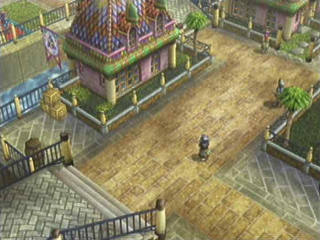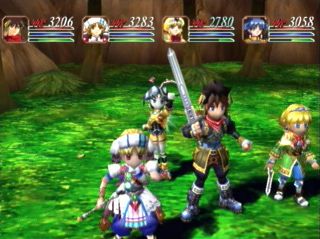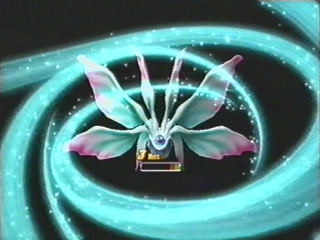The Grandia 2 Review Page.
Genre: RPG. (Mostly turn based. Although you can sometimes force enemies to avoid having a turn.)
Memory Requirements: 9 blocks (per save)
 I’ve been wanting to get this game for AGES. I thought about buying it back in like 2000, when I saw it at Electronics Boutique, but at the time I couldn’t afford it, probably ’cos I’d just bought a bunch of other games at the time, or something. Anyway, since then, I’ve been kicking myself that I never did get it, ’cos until recently I never saw it again. I tried looking for it in 2002 when I was in England, but had no luck either, despite that Dreamcast games were really easy to get still. So recently I found a 2nd hand copy at The GOAT Store for a reasonable price.
I’ve been wanting to get this game for AGES. I thought about buying it back in like 2000, when I saw it at Electronics Boutique, but at the time I couldn’t afford it, probably ’cos I’d just bought a bunch of other games at the time, or something. Anyway, since then, I’ve been kicking myself that I never did get it, ’cos until recently I never saw it again. I tried looking for it in 2002 when I was in England, but had no luck either, despite that Dreamcast games were really easy to get still. So recently I found a 2nd hand copy at The GOAT Store for a reasonable price.
I knew of Grandia first from the original game that came out in Japan on the Saturn, but I never got it, because (1.) I can’t read Japanese all that well, and (2.) my Saturn doesn’t have a region changing switch in it to play the Japanese games either. Anyway, thankfully the 2nd game did have an English version that I could get. There’s 3 systems that it comes on, the Dreamcast, the PlayStation 2 and the PC, for Windows. Apparently the Dreamcast version is the best of the 3 from what I’ve heard, and that the other 2 got a bit of a bad conversion. That’s fine by me, but I haven’t seen the other 2 ones running to say any different. But, anyway, you play as a Geohound named Ryudo, who’s let’s face it, a really cynical jerk at the start. Hee, hee. He’s pretty bitter through nearly the entire game, although he occassionally lets a more caring side of himself show through. His 1st mission is to escort the Granas Songstress, Elena, to the Black Tower, I think it was called. Here she’s supposed to be singing in a
ritual to seal in a part of the devil, Valmar. Well, it all goes horribly wrong, and Ryudo finds Elena inside, possessed by the Wings Of Valmar, who take on the form of a woman called Millenia that appears whenever she damn well pleases, although a lot of the time when Elena is resting. She’s got firey red hair, and an attitude that more than matches it. She’s often very cruel and nasty, as you’d expect from what she is, but there is a softer part of her that comes up from time to time, and when she starts to get deeper feelings for Ryudo, things kinda get a bit different in her nature.
You also meet up with a young kid called Roan, with real yellowy coloured hair, and when he joins your party, you can make use of a few of his cool moves aswell. At various locations, you’ll stop for the evening, and you can have a conversation with each of the party members by choosing who you want to speak. When the conversation is about over, the hand above Ryudo’s head will turn to a “Good Night” icon, so you can actually start the next day. Save points appear as they did in the 1st Grandia — a rainbow coloured cone. Here you can also rest and restore all your attributes, including any status disorders. You can also do the same at inns in most towns.
The magic system I found was rather unique. Instead of each character learning a spell, the spells belong to Mana Eggs, which can be swapped in any fashion between the characters. The same also applies to Skill Books, which boost certain properties of the character they’re equipped on. You can power up Mana Eggs with Magic Coins, and Skill Books with Special Coins, which you get at the end of most battles. There’s also an A.I. system, which will allow the characters to do battle automatically, and this can be set to: Manual, Go Wild, Play Fair, Safety 1st, Power Up, Meanie, Withdraw or Each Own, which goes on the player’s personality. Of course you’ll probably want it set to manual, so you can choose what each character does, but you can mix and match. If you have Millenia in the crew, she’ll often go berserk, with her Rage System and when this happens, you have no control over her, but she will unleash all sorts of powerful moves on the enemy.
Battles start in 3 different ways - if you come up behind the enemy, you will have initiative and go 1st, but if the enemy comes up behind you, then you’ll have to wait for their turn. If you both see each other coming, then the battle will start normally. So it’s often an advantage to start a battle yourself, when you see enemies about. The battle system is sort of turn based, but it works on what’s called an
I.P. (initiative points) gauge. So basically a player or enemy’s turn comes up depending on how fast their I.P. recovers, and this can be altered in battle, or by wearing certain items. Some boss type enemies are very fast at recovering, so they’ll overtake you on ocassions. This can be prevented by cancelling them, which effectively prevents them from having a turn. Of course this works against your party also from enemy cancel moves. Watching the gauge, and seeing who’s doing what can be a big advantage in battle, and if you’re tricky enough, you can prevent enemies from having a go at all.
I was a bit dissapointed that you couldn’t go back to all of the places you’d already been before at later stages in the game, so I suppose you need to make sure you finish up everything you want to do, and collect all you can find while you’re in a place before moving on. Sometimes I felt the urge to rush through an area to find out what was going to happen next in the story also.
The instruction manual is pretty decent also — it has 64 pages, and it’s actually all in colour, unlike most of the PAL Dreamcast game manuals I have. It goes into detail on just about EVERYTHING too, so if you want to know something, it’s pretty easy to look up.



The version of the game that I’ve got is the American one, but I don’t think it’s actually got any differences that I know of. It was interesting to note though, that when I loaded the game, it actually runs in the PAL 50 Hz mode, like Puyo Puyo Fever does, which suggests that when you’re using a boot disc, the game just “presumes” that it’s running on the hardware it was meant to, or something, and doesn’t need to set the output mode, or whatever, so it’s like the Dreamcast’s just cracking off its default setting. Maybe something like that. Then I suppose if you had a switch in the console to set the region, it would change the output to NTSC or PAL accordingly perhaps.
Graphics: The characters are kinda simple looking, but there is good attention to detail especially in some of the surrounding environments. You’ll find nice looking trees, buildings, some great looking fire, nifty magical special effects and a typical style that seems to run throughout everything. The lighting effects are really good, where you’ll notice nice smooth gouraud shading, and in battles, bright glowing effects stretch the characters’s shadows off in believable perspectives. The shadows change between battle areas and simply wandering around the towns. In a battle they’re sort of soft looking hexagonal shapes, but in towns they’re more simple ovals, kind of like in Skies Of Arcadia. You’ll also spot shadows that are coloured from transparent bottles and so forth, which looks neat… A lot of the special effects use videos also, with an alpha channel, so that you end up with some quite complex looking effects at times. All in all, it looks pretty solid, and
you won’t see any clipping or fading in scenery, due to the isometric camera angle at most times. The texturing is well done, and doesn’t have a lot of noticeable edges. In a lot of the rocky scenery, and grassy coverered parts of land, it seems to wrap believably around it. In one particular area where you climb up and down rock ledges protruding from the cliffs, you get the feeling that they really are carved out of the rock, rather than looking as if they’d been glued on. The videos use the MPEG format, and SFD, so they’re all of really good quality, as you’d expect. 89%
Animation: The animation is always really smooth in all the real time stuff, although some of the videos seem to be noticably slower. The White Apocalypse one of Elena’s seemed as though the Dreamcast’s drive couldn’t keep up when doing the audio. The water effects seem quite smooth in all the areas that they appear also. Generally it’s pretty good. 90%
Sound: The music is excellent in Grandia 2, composed by Noriyuki Iwadare, and each area has it’s own theme, kind of like in Skies Of Arcadia, I suppose. It’s a pity that the soundtrack CD wasn’t as comprehensive as I’d’ve liked. (You need to get the additional Povo and Melodia CDs to get everything.) The speech is clear, there’s some top notch footstep sounds, and lots of variety in all the other miscellaneous effects, including ambient noises. 95%
Playability: It’s easy to get into, although at times it can feel
quite frustrating when you’re itching to find out what happens next, and you’re plagued by what seems like endless battles. Being able to restore your attributes at the save points is a nifty idea also. 80%
Lastability: The game certainly keeps you interested in what’s going to progress in the story line, and at times I felt really absorbed by what was going on. You often feel quite a lot of emotions, happiness, excitement and especially despair… There’s a lot of areas, where you just want to get passed a bunch of monsters and so forth to see what’s going to happen next in the story. 96%
Overall: Grandia 2 is certainly a great RPG, and there’s some pretty solid gameplay and story line to be found. If you take your time, and search all the areas, do every battle you can, and talk to everyone, you could be looking at over 50 hours worth of playing. It can be a bit annoying in some places, but if you stick with it, then it becomes more rewarding. 91%
